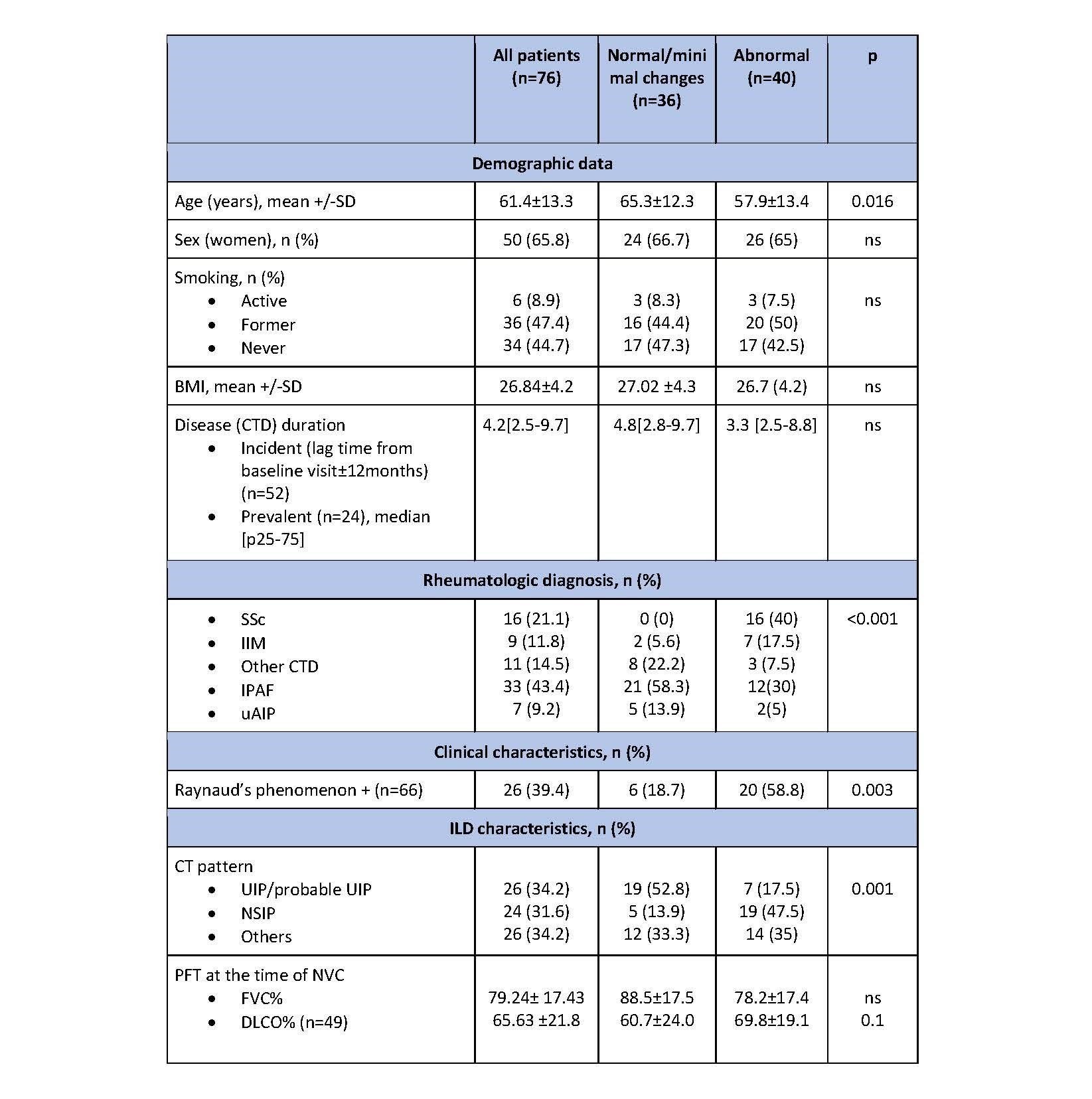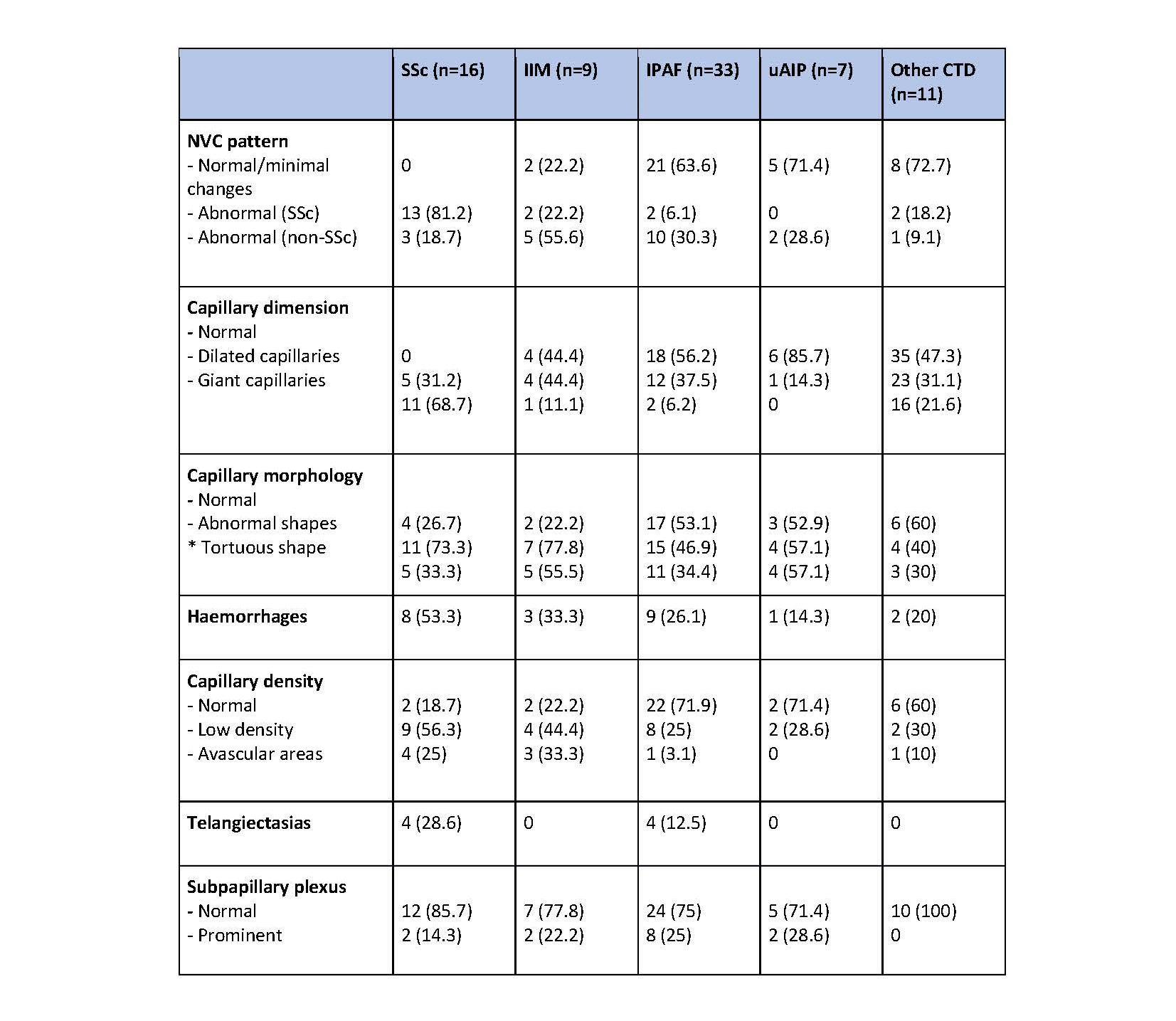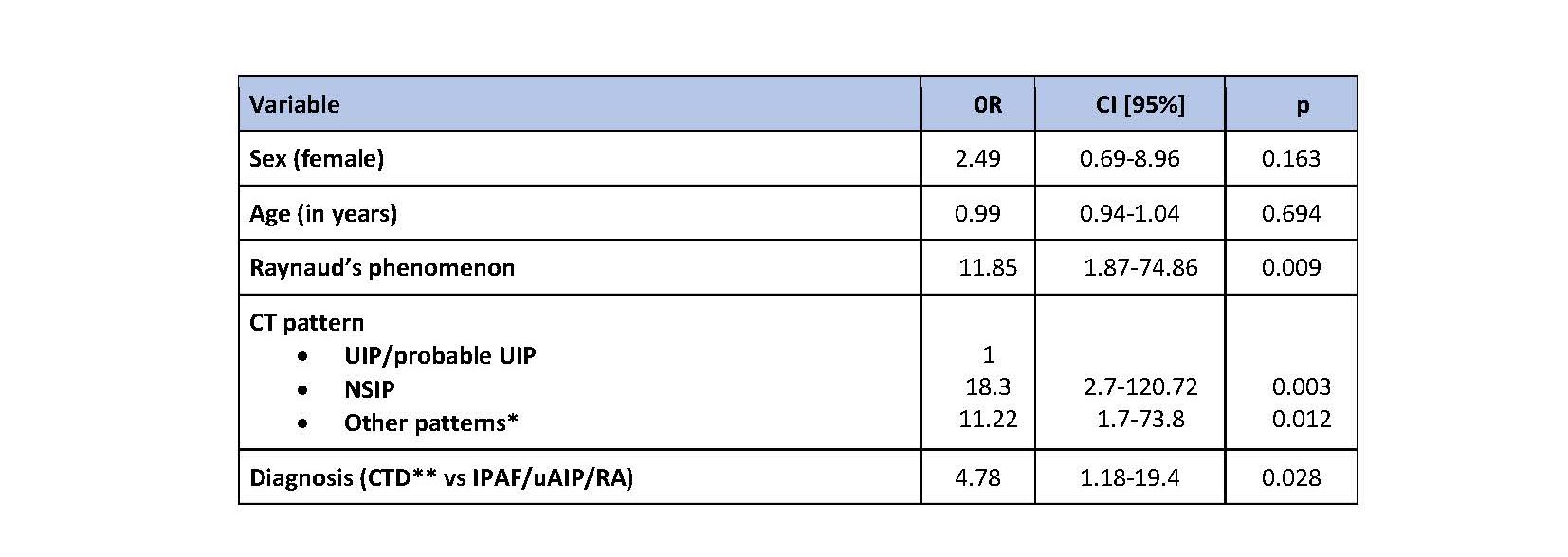Session Information
Date: Sunday, November 12, 2023
Title: (0609–0672) Systemic Sclerosis & Related Disorders – Clinical Poster I: Research
Session Type: Poster Session A
Session Time: 9:00AM-11:00AM
Background/Purpose: The aim of this study is to describe the nailfold video-capillaroscopy (NVC) findings in patients with interstitial lung disease associated to connective tissue diseases (CTD-ILD), interstitial pneumonia with autoimmune features (IPAF) or undifferentiated autoimmune interstitial pneumonia (uAIP), and to assess the association of ILD features with abnormal NVC findings.
Methods: This is a cross-sectional study from a multicenter prospective registry (NEREA) of patients with a clinical diagnosis of ILD in the context of an autoimmune disease including CTD-ILD, IPAF or uAIP, from 10 hospitals in Madrid. All patients with available data on NVC were included. NVC studies were performed according to standardized definitions from the EULAR study group on capillaroscopy. Main outcome: abnormal NVC pattern (including systemic sclerosis [SSc] pattern and non-SSc pattern).Independent variables: radiographic patterns grouped as UIP (usual interstitial pneumonia), NSIP (non-specific interstitial pneumonia) and others. Covariates: demographics, clinical diagnosis. Statistics: For bivariate associations, Student’s t-test, Mann-Whitney test or Kruskal-Wallis test were used for the analysis of continuous variables while categorical variables were analyzed with Chi-square or the Fisher test. A logistic regression multivariate model was also run (Odds ratio (OR) and 95% Confidence Interval [CI]).
Results: Seventy six patients with a mean age of 61.4 ± 13.3 years (66% women) were included (Table 1). Main clinical groups were IPAF (33 patients, 43.4%) and SSc (16 patients, 21.1%). NVC was classified as normal/minimal changes in 36 (47.4%), SSc-pattern in 19 (15%) and non-SSc pattern in 21 (27.6%) patients, respectively. Abnormal NVC was associated with younger age (p=0.016), Raynaud’s phenomenon (p=0.003), and a non-UIP pattern on CT (p=0.001). There were statistically significant differences among clinical subgroups (p< 0.001), with a higher number of abnormal NVC in SSc and IIM groups. With regards to antibody status, an abnormal NVC pattern was associated with positive ANA (p=0.002) and SSc-specific antibodies (p=0.002). Although abnormal NVC was associated with Raynaud’s phenomenon, in our cohort we also found abnormal NVC in 14 out of 40 patients (35%) without this manifestation. NVC features are detailed in table 2.
In the multivariate analysis, non-UIP patterns (NSIP and others), CTD and Raynaud’s phenomenon were independently associated with abnormal NVC (table 3).
Conclusion: NVC may be a useful tool in the assessment of patients with autoimmune ILD. Besides the acknowledged association of NVC lesions with SSc and IIM, our findings support that performance of NVC may help identify an underlying autoimmune disease in patients with ILD and a non-UIP radiographic pattern.
SSc=systemic sclerosis, IIM=idiopathic inflammatory myopathy, IPAF=interstitial pneumonia with autoimmune features, uAIP=undefined autoimmune interstitial pneumonia, CT=computerized tomography, UIP=usual interstitial pneumonia, NSIP=non-specific interstitial pneumonia, PFT=pulmonary function tests, FVC=forced vital capacity, DLCO= Diffusing capacity for carbon monoxide.
SSc=systemic sclerosis, IIM=idiopathic inflammatory myopathy, IPAF=interstitial pneumonia with autoimmune features, uAIP=undifferentiated autoimmune interstitial pneumonia
CT=computerized tomography, UIP=usual interstitial pneumonia, NSIP=non-specific interstitial pneumonia, CTD=connective tissue disease, IPAF=interstitial pneumonia with autoimmune features, uAIP= undifferentiated autoimmune interstitial pneumonia, RA=rheumatoid arthritis
*Other patterns= organising pneumonia, lymphocytic interstitial pneumonia, micronodular/peribronchovascular abnormalities.
**CTD=connective tissue disease (systemic sclerosis, idiopathic inflammatory myopathy, mixed connective tissue disease, Sjögren’s syndrome, systemic vasculitis).
To cite this abstract in AMA style:
Loarce-Martos J, Godoy H, Cebrian L, Rodriguez-Nieto M, Rigual J, Laporta R, Lopez-Muñiz B, Abasolo l, Sanchez Pernaute O, Romero F. Abnormal Nailfold Video-capillaroscopy Is Independently Associated with non-UIP Radiographic Patterns in Autoimmune ILD: A Multicenter Study from the NEREA Registry [abstract]. Arthritis Rheumatol. 2023; 75 (suppl 9). https://acrabstracts.org/abstract/abnormal-nailfold-video-capillaroscopy-is-independently-associated-with-non-uip-radiographic-patterns-in-autoimmune-ild-a-multicenter-study-from-the-nerea-registry/. Accessed .« Back to ACR Convergence 2023
ACR Meeting Abstracts - https://acrabstracts.org/abstract/abnormal-nailfold-video-capillaroscopy-is-independently-associated-with-non-uip-radiographic-patterns-in-autoimmune-ild-a-multicenter-study-from-the-nerea-registry/



